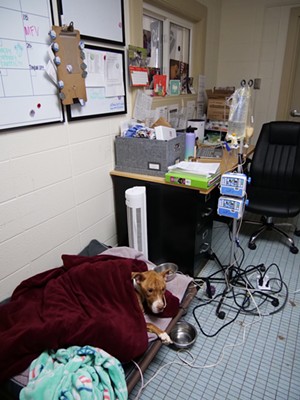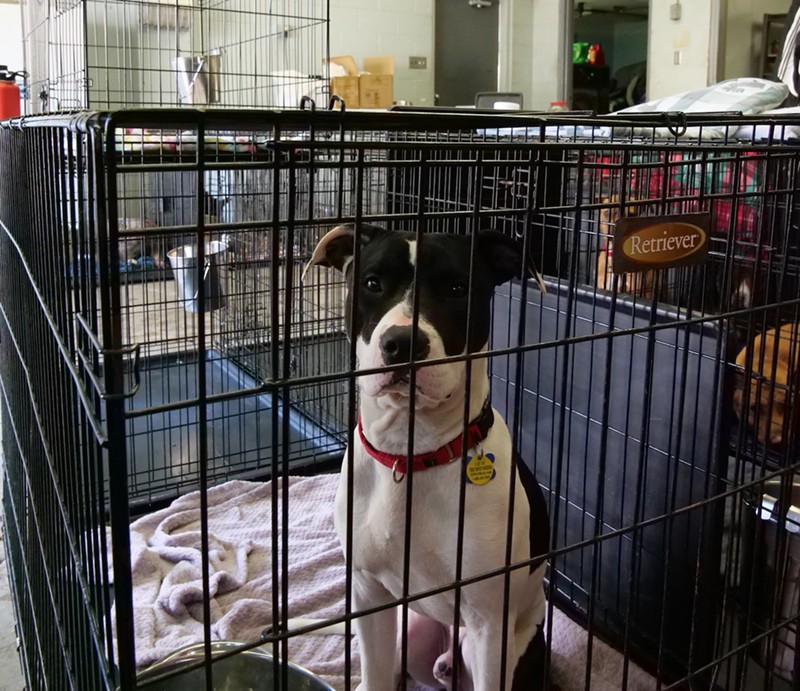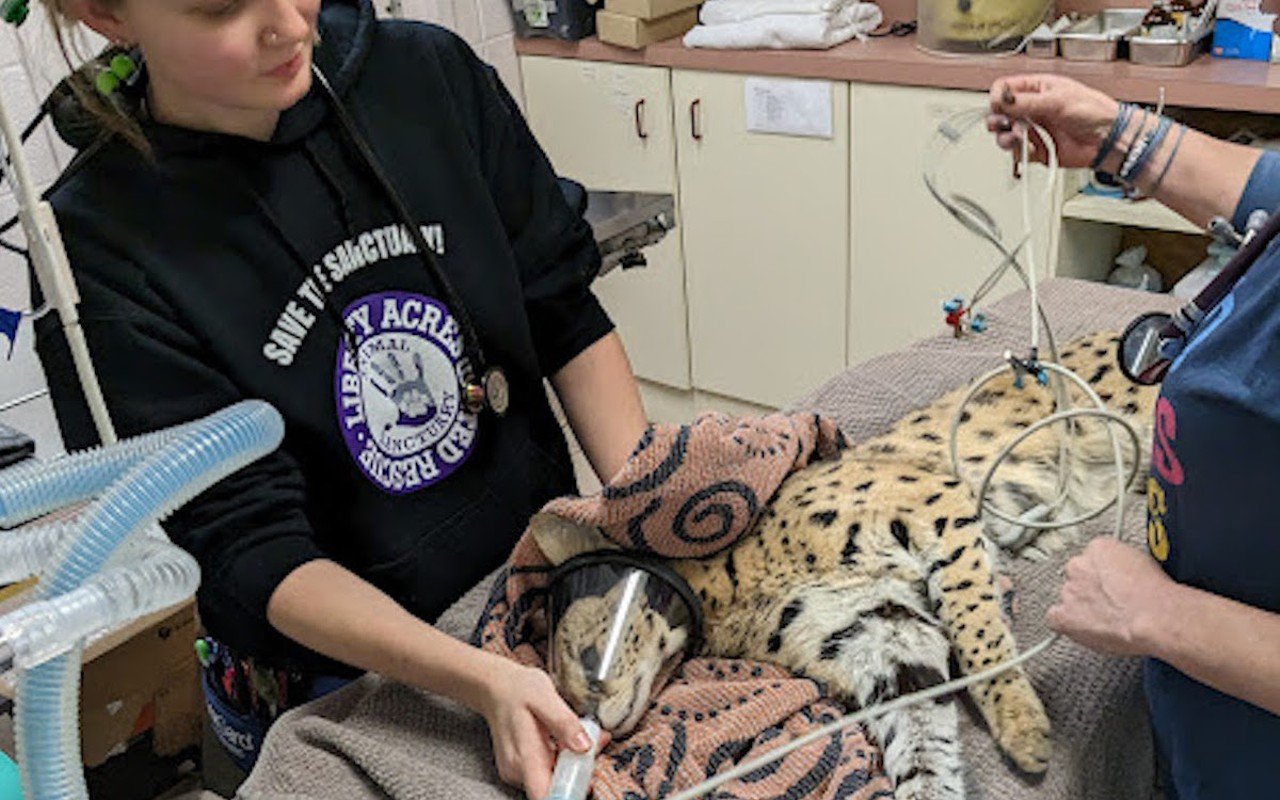This story is featured in CityBeat's March 22 print edition.
Glenda the dog is hooked up to a feeding tube, laying on a warm bed next to the desk of the vet working to save her life.
She was found locked in a cage in an apartment stairwell, covered in her own waste and severely emaciated when good samaritans brought her to Cincinnati Animal CARE (CAC) in Northside. The staff at CAC keep a close eye on Glenda, but she’s not sleeping in an office because of her condition – there’s just no kennel for her.
“This is a space issue,” Ray Anderson, CAC community engagement manager, tells CityBeat. “If we had a better hospital suite, a quiet place for patients to go… but she’s immobile and there is no kennel to put her in right now.”
CAC, which Anderson says is Hamilton County’s only open-intake animal shelter, has only 100 kennels it considers to be appropriate for the well-being of their dog population. Those kennels are part indoor, part outdoor, giving dogs some room to move around and get fresh air.
But 100 kennels doesn’t begin to cover the demand at CAC, and that demand seems to be increasing.
“As of [March 1], there were 197 dogs being housed at Cincinnati Animal CARE. In 2022, we averaged 179 dogs on-site each day. I believe our highest at any point is 235,” Anderson says.
Anderson says CAC has been housing the overflow of dogs in backup cages that don’t have an indoor-outdoor option, and there’s only so much room for the few dozens of cages.
“This should not be the solution, but it’s the reality of what we’re dealing with right now,” Anderson says while pointing to rows of overflow kennels in an air-conditioned garage, the dogs’ excited barks echoing against concrete walls. “100 dogs at a time is really what we’re built to house, and if we just had those kennels to focus on at any given time, we’d be in great shape.”
To CAC’s relief (and a dog’s delight), other spaces for dogs that don’t have a kennel can include offices, which are often shared by multiple staff members. Anderson shares his office with a wiggly one-year-old mixed breed named Prosecco. She jumps and nuzzles her nose on his lap for treats while he works, her bubbly personality living up to her name. Anderson gives her a nibble of a donut, which she takes gently.
“That’s a gooood girl,” he tells her.
Anderson doesn’t mind sharing his office with Prosecco, or really any dog that comes through CAC’s doors, but overcrowding is still a concern as the staff works tirelessly seven days a week to keep each dog comfortable and stimulated. Anderson says the space issue is actually the result of more humane treatment than animals were experiencing when Cincinnati SPCA was operating the shelter (Cincinnati SPCA is not affiliated with the American Society for the Prevention of Cruelty to Animals, known as the ASPCA).
“There’s no longer euthanasia for space or length of stay,” Anderson says. “If it gets too full in here, it used to be you’d see four, five, six dogs in a kennel together. We have a strict one-dog-per-kennel policy.”

Reconciling past and present
Cincinnati SPCA is the private organization that previously operated the Hamilton County animal shelter in Northside starting in 1965, though it’s been around since 1873 when it became one of Ohio’s first animal shelters. While also running a private shelter in Sharonville, Cincinnati SPCA was Hamilton County’s private-public hybrid shelter for decades before Cincinnati Animal CARE took over in 2020. A spokesperson for Cincinnati SPCA tells CityBeat that the organization decided to end its decades-long partnership with the county because of funding issues.
“As an organization, the SPCA Cincinnati chose not to renew the contract with the county due to lack of funding by the county,” the SPCA tells CityBeat. “At the conclusion of SPCA Cincinnati’s contract with the county, the Northside facility was left with empty cages and our organization was operating at 90% live release rate.”
Anderson says he’s skeptical of the idea that there were empty cages during SPCA’s tenure, saying accounts from previous volunteers suggests hundreds of dogs were dying each year from kennel sharing, a practice he says is dangerous for dogs as well as for the humans who interact with them.
“When you have four dogs in a kennel together and you’re feeding them together, that leads to problems,” Anderson says. “We were seeing an average of 300 dogs dying per year in their cages with the other animals. They were killing each other.”
SPCA tells CityBeat that kennel-sharing was common practice under SCPA management but that starting in 2017, it was greatly reduced until the shelter was down to one dog per kennel. SPCA says Anderson’s claim that hundreds of dogs were dying each year from kennel-sharing is not accurate.
“There is no way to provide a number on the dogs which passed due to harm inflicted on another dog as a result of kennel sharing. This is because the occurrence was so low; the incidents were few and not at a significant rate,” SPCA says.
Anderson also attributes Cincinnati Animal CARE’s space issues with a lower euthanasia rate for dogs since taking over as the county shelter.
County data provided to CityBeat shows that Cincinnati SPCA euthanized 11,618 dogs between 2011 and 2019, the last full year the SPCA ran the Hamilton County shelter.
The SPCA admits the numbers were high but says the organization has made strides recently in reducing euthanasia overall.
“The euthanasia numbers are higher in years past, as would be any humane society in the business with our tenure. Those numbers predate the work which has since been done as a whole in our community to combat said challenges,” the SPCA says. “The SPCA Cincinnati has consciously worked with other organizations to reduce pet overpopulation, like The Joanie Bernard Foundation, and our humane society has initiated programs that keep pets healthy and in loving homes, like our Chow Now Pantry and Humane Education programs.”
The number of dogs euthanized during SPCA’s final full year running the Hamilton County Animal shelter in 2019 was 967.
Data provided to CityBeat from CAC shows that 167 dogs were euthanized in their care in 2022. Of those cases, 40 were for chronic illness or injury.
“Critical injury, terminal illness, those are things that the average pet owner might have to euthanize their pet for,” Anderson says.
One of the cases of euthanasia was court-ordered, and the other 126 cases were classified as behavioral or temperamental. CAC determined that some of these dogs were an imminent threat to public safety after repeated or severe bites, while other dogs had displayed signs of mental distress and deterioration. Anderson says the mental deterioration problem becomes worse the longer a dog stays at the shelter, which has been a growing problem at CAC.
“The more we have animals coming in who do stick around, we start to see that quality of life deteriorate,” Anderson says. “It’s not just, ‘Oh, he looks sad.’ It’s that he’s digging at the concrete in his kennel to the point he wears his nails down to blood.”
When staff start to notice this kind of digging, spinning or jumping in a pattern that signals a panicked, stressed dog, Anderson says it’s critical to either adopt out the dog or place them in a foster home as soon as possible. Otherwise they may need to be euthanized.
“If we feel they’re too far gone, that – to us – is not humane to keep an animal in that kind of living condition,” he says.

Training the wardens and agents
Glenda the dog died just a few days after CityBeat visited Cincinnati Animal CARE, but she was not euthanized. Anderson says Glenda died in her sleep after arriving at CAC in critical shape due to emaciation. In situations like this, the Hamilton County dog warden steps in to investigate the possibility of cruelty charges.
“Our medical team believes she had likely been ill for quite some time. I cannot comment further as it’s now an open investigation being personally handled by chief dog warden Troy Taylor,” Anderson said.
Including Taylor, CAC has seven dog wardens on staff who are all sworn humane agents for the state of Ohio. Taylor’s work uniform and protective equipment aligns him visually with police officers or sheriff’s deputies, but the position of dog warden is unique in its own right. County dog wardens are sworn in by a county judge to enforce state law but are not members of the sheriff’s office. The sheriff’s office does, however, provide oversight if there were to be a complaint against a dog warden, such as excessive use of force or improper conduct.
Private shelters like Cincinnati SPCA have humane agents who are not dog wardens. Anderson says understanding the distinction is important, especially when private humane agents appear visually similar to dog wardens.
“Anybody can be a sworn humane agent. Anybody can go through humane agent training,” Anderson says. “The difference is when they are sworn in by a judge – which I believe SPCA Cincinnati’s have been – they still don’t have prosecutorial power or backing.”
When sharing details about humane agent training, SPCA says agents are approved by a judge.
“Humane agents must successfully complete a minimum of twenty hours of training on issues relating to investigation and prosecution of cruelty and neglect of animals, then be approved by a probate judge in the county,” the SPCA says.
In addition to having the power to issue dog licenses and taking in strays, Hamilton County dog wardens prosecute cases relating to animals, and CAC’s short tenure as the county’s shelter already has been dotted with shocking and strange cases.
On March 8, Taylor, the chief dog warden, filed felony charges in the case of Dwayne Dickey, a suspect accused of breaking into a Clifton apartment and fatally shooting the resident’s dog, Raya. And on March 9, agents for the county recovered the last of three stolen puppies that had been missing for weeks.
Most notable in 2023 so far has been Cincinnati Animal CARE’s recovery of a serval cat with cocaine in its system. Dog wardens seized it from a tree in Oakley without the use of weapons or tranquilizers. While Amiry the cat suffered a broken leg during the confrontation, Anderson says the wardens could have suffered way more. CAC brought in a big cat expert to confirm the breed of the 35-pound serval cat, who took little time reaching a conclusion.
“He came in and took one look at it and said, ‘Oh, no, that’s absolutely a serval,’” Anderson says. “He asked us how we got it out, and I told him that the dog wardens climbed up a tree and got it, and he told us, ‘I would rather deal with a tiger.’”
Charges for the illegal possession of the serval and for the presence of cocaine in its system aren’t being filed at the moment, but Taylor says charges are still possible.
“Just because we said no charges are being filed now doesn’t mean they won’t be in the future. This is an ongoing investigation, we’re still looking into that,” Taylor says.

Clearing up confusion
Anderson worries the lack of public understanding of the differences between private humane agents vs. county dog wardens could create confusion for those wondering if Cincinnati SPCA is still the county shelter.
With Cincinnati SPCA’s decades of history in Northside, Anderson says a large educational campaign is needed to shift the public’s understanding of who is in charge of animal welfare in Hamilton County. He says it could take ten years for public consciousness to catch up to the administration change.
“I’d say it’s probably our biggest hurdle in terms of outward messaging,” Anderson said. “The fact that SPCA Sharonville was running Hamilton County operations for 60 years – that’s a long time.”
Anderson wants to shift the narrative about hometown animal welfare to Cincinnati Animal CARE, which currently runs Hamilton County’s services.
“We’re what you think of when you want to donate money to ‘the dog pound’ or you want to help out the shelter, we’re who you give money to now. SPCA Cincinnati still exists, still accepts donations, but they’re a private organization with managed intake,” Anderson says. “That’s a big distinction. That’s going to be a decade-long project.”
According to Anderson, total expenses for operating CAC were $4.3 million in 2021 and $4.75 million in 2022. Anderson praises the county for its financial assistance and repairs to the aging CAC building on Colerain Avenue but says the shelter will be expected to raise funds to partially cover the cost of operations. CAC’s fund-raising goal for 2023 is $1 million.
While Cincinnati Animal CARE straps in for the long-haul effort to establish its fund-raising arm, the Hamilton County board of commissioners is searching for land to build a new county shelter, which CAC will continue to operate. John P. Bruggen, assistant county administrator for Hamilton County, tells CityBeat that construction of the new shelter could take three to five years after the land is purchased. The estimated cost for the new shelter isn’t yet clear.
To remedy the issue of overcrowding and long-time shelter dwellers in the meantime, CAC is calling on dog-lovers to consider fostering a dog.
“With 100 kennels and 8,000 animals annually, there’s no way we could house only one dog per kennel and be a no-kill organization without fosters,” Anderson says. “They literally save lives everyday.”
Fostering is free, and Cincinnati Animal CARE provides the necessary supplies and veterinary care, depending on the needs of the dog. CAC works with each foster family to create a custom agreement based on the family’s availability and if they already have pets in their home. Fosters can house a dog indefinitely, for one day, or for a “slumber party,” Anderson says.
CAC fosters dogs, cats and other small animals that might come to the shelter, but Anderson says dog fosters are their greatest need right now.
Those who are interested in learning more about fostering can attend the CAC Foster Open House at 6 p.m. March 31 at the shelter at 3949 Colerain Ave. in Northside.
While CAC waits for the space they need, Anderson is looking ahead to a future where Hamilton County’s dogs can all live their best lives.
“Gone are the days of the dog pound,” Anderson says. “But we don’t do this alone – this is a community effort, and we need an active and engaged community to make this happen.”
CAC’s More Surprising Animals
Amiry the serval cat is not the only oddball animal seen by Cincinnati Animal CARE staff. In fact, Amiry isn’t even the only exotic animal to test positive for drugs at the shelter.
“The highest profile one that we’ve dealt with in the past two-and-a-half years was Neo the capuchin monkey, who was given methamphetamines,” says Ray Anderson, community engagement manager. “That case is a case that we just wrapped up and won. That monkey is safely at an undisclosed location now resting comfortably at a sanctuary.”
Beyond the wild and exotic, most of the more peculiar animals at CAC are farm-types, like chickens and goats.
“A decent number of pigs will come through [and] I think we just had a goat,” Anderson says. “A peahen – we had a female peacock come through. Lots of roosters, lots of chickens. That’s becoming more and more common because people have chickens in their backyard now. Anytime we get a rooster, they go against city code, so we have to take those in.”
Anderson spoke affectionately about one misfit animal in particular – one people normally consider a nuisance, or at least on trash day.
“We had a domesticated raccoon back in 2020 that was pretty fun. His name was Edward Scissorhands,” Anderson says. “He would sit right on your shoulder, and it looked like you were wearing a Daniel Boone cap. He was the sweetest thing. He went to a sanctuary, as well.”
There are some animals that are more difficult to take in, so CAC will work with area rescues with a specific animal specialty.
“We get the occasional raptor hawk or eagle. We have raptor rescues that we work with in those cases. We’ve dealt with a few horse cases as well,” he says.
Sometimes the animal isn’t the only odd thing CAC staff sees, it’s the way the animal ends up in their care.
“Once we had a case where the police chased a suspect in a foot pursuit and when they tackled him his bearded dragon popped out of his pocket, we’ve had that happen before,” he says.
Coming soon: CityBeat Daily newsletter. We’ll send you a handful of interesting Cincinnati stories every morning. Subscribe now to not miss a thing.
Follow us: Google News | NewsBreak | Reddit | Instagram | Facebook | Twitter








